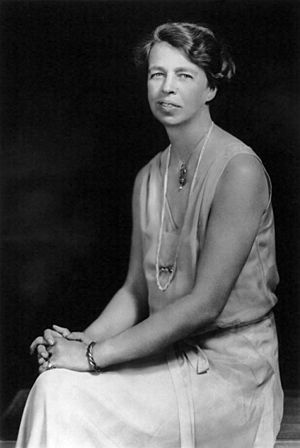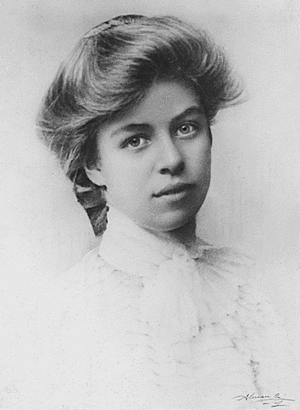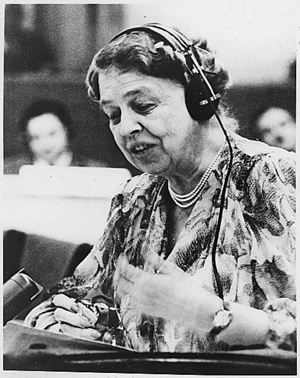Eleanor Roosevelt facts for kids
Quick facts for kids
Eleanor Roosevelt
|
|
|---|---|
 |
|
| United States Delegate to the United Nations General Assembly | |
| In office December 31, 1946 – December 31, 1952 |
|
| President | Harry S. Truman |
| President and Chair of the United Nations Commission on Human Rights | |
| In office 1946–1952 |
|
| Preceded by | New Position |
| Succeeded by | Charles Malik |
| Chair of the Presidential Commission on the Status of Women | |
| In office 1961–1962 |
|
| President | John F. Kennedy |
| Preceded by | New Office |
| Succeeded by | Commission work taken over by Esther Peterson after Commissioner Roosevelt's death |
| First Lady of the United States | |
| In office March 4, 1933 – April 12, 1945 |
|
| Preceded by | Lou Henry Hoover |
| Succeeded by | Elizabeth "Bess" Wallace Truman |
| Personal details | |
| Born |
Anna Eleanor Roosevelt
October 11, 1884 New York, New York |
| Died | November 7, 1962 (aged 78) New York, New York |
| Cause of death | Tuberculosis |
| Resting place | Hyde Park, New York |
| Political party | Democratic |
| Spouse | Franklin D. Roosevelt |
| Children | Anna Eleanor, James, Elliott, Franklin, John |
| Residence | Hyde Park, New York |
| Occupation | First Lady, diplomat, activist |
Anna Eleanor Roosevelt (October 11, 1884 – November 7, 1962) was an important American leader. She was the longest-serving First Lady of the United States, from 1933 to 1945. Her husband, Franklin D. Roosevelt, was president for four terms.
Eleanor Roosevelt was also a strong political leader herself. She supported the American civil rights movement. After her husband died in 1945, she became an author, speaker, and advocate for human rights. She changed what it meant to be a First Lady. President Harry S. Truman called her the First Lady of the World. This was because she traveled a lot to promote human rights.
She received 35 special degrees during her life. These were called honorary degrees.
Contents
Eleanor Roosevelt's Early Life
Where Did Eleanor Roosevelt Grow Up?
Eleanor Roosevelt was born in New York City, New York. Her parents were Elliott Roosevelt I and Anna Hall Roosevelt. She had two younger brothers, Elliott Jr. and Hall Roosevelt. Eleanor was a distant cousin of Franklin D. Roosevelt, who later became her husband.
Her uncle was Theodore Roosevelt, who was also a President of the United States. He was like a father figure to her. Eleanor preferred to be called Eleanor, using Anna Eleanor only for official papers. Her family had been in America since the 1640s.
Eleanor Roosevelt's Childhood Challenges
Eleanor's parents died when she was young. After this, her grandmother, Marry Ludlow Hall, raised her. She lived in Tivoli, New York. Some family members were not always kind to her. They sometimes made comments about her looks.
Eleanor sometimes felt insecure at her grandmother's home. She once told her aunt, Bamie Roosevelt, that she felt she had "no real home." Aunt Bamie was very helpful. She wanted Eleanor to have a good education. So, she arranged for Eleanor to study in England. Eleanor was happy to go.
Eleanor Roosevelt's Education in England
Eleanor went to a girls' boarding school called Allenswood. It was located outside London, England. She studied there from 1899 to 1902. Her headmistress, Mademoiselle Marie Souvestre, was very important to her. Eleanor later said Souvestre was one of the three people who most influenced her life.
During summer breaks, Eleanor traveled around Europe with Souvestre. She studied history, languages, and literature. She became interested in social justice. Her studies helped her gain knowledge and confidence. She learned to share her ideas on many topics. She even made the field hockey team at school. She was a favorite student, and the school missed her when she returned to the USA.
Eleanor Roosevelt and Franklin D. Roosevelt's Marriage
In 1902, Eleanor met Franklin Delano Roosevelt (FDR). He was a student at Harvard University. They started dating and got engaged in November 1903. FDR’s mother did not want them to marry. She even sent FDR on a long trip to try and change his mind.
But on March 17, 1905, FDR and Eleanor got married. President Theodore Roosevelt, Eleanor's uncle, walked her down the aisle. After they married, FDR's mother continued to try and influence their lives.
After her husband died in 1945, Eleanor Roosevelt lived at the Hyde Park Estate. She lived in a stone cottage near the main house. This cottage was once a small furniture factory. It was changed into a home for Eleanor and her friends. Eleanor felt it gave her the privacy she wanted. She called it her "first true home." Today, it is the Eleanor Roosevelt Center. It hosts programs that continue her work.
Eleanor Roosevelt as First Lady
Eleanor became First Lady in 1933. This was when her husband started his first term as President. Eleanor was a very active First Lady. She had her own strong ideas on many issues.
She strongly supported the American Civil Rights Movement. She also supported the rights of African Americans. Her husband, Franklin Roosevelt, needed support from southern states. So, he was not as open about the Civil Rights Movement. Eleanor became his link to the African-American community. She helped him gain many votes.
In 1939, an African-American opera singer named Marian Anderson was not allowed to perform. The Daughters of the American Revolution denied her use of DAR Constitution Hall because of her race. Eleanor stepped in. She arranged for Anderson to sing on the steps of the Lincoln Memorial. This happened on Easter Sunday. About 70,000 people listened live. Millions more heard it on the radio.
Eleanor Roosevelt During World War II
During World War II, Eleanor Roosevelt stayed very busy. She helped lead a committee on civil defense. She visited many places, both civilian and military. She wanted to boost people's spirits during the war. She especially supported African Americans and women.
During the war, her husband signed an order called Executive Order 9066. This order sent about 110,000 American citizens of Japanese descent to special camps. Eleanor did not agree with her husband's decision to sign this order.
For a time, she earned money by advertising for the Pan-American Coffee Bureau. This Bureau was funded by eight foreign governments. The US State Department tried to stop this, but they could not.
Eleanor Roosevelt's Postwar Work
After World War II, Eleanor Roosevelt helped write an important document. It was for the United Nations. This document was the UN Universal Declaration of Human Rights. She also became the first leader of the U.N. Human Rights Commission. The United Nations General Assembly approved this declaration on December 10, 1948. This was a huge achievement for her. It made her very famous.
Eleanor was involved in politics for about 40 years. This was from the 1920s until her death in 1962. She did not support the Equal Rights Amendment. She believed it would stop Congress from passing other laws to protect women workers.
Eleanor Roosevelt was also a skilled archer. She was one of the first modern women to hunt with a bow. She even wrote about her hunting trips. She used a male name, "Chuck Painton," for a popular hunting magazine. One of her hunting trophies was in her husband's library. It is now in the Smithsonian Institution.
Eleanor Roosevelt and the Catholic Issue
In 1949, Eleanor had a public disagreement. It was with Francis Cardinal Spellman, a Catholic Archbishop in New York. Eleanor had written against using public money for some activities at Catholic schools. Spellman said that the Supreme Court had already approved such things. He also accused her of being against Catholics.
Most Democrats supported Eleanor Roosevelt. Spellman later visited Eleanor at her home to resolve their differences. Eleanor was never as popular with Catholics as her husband was. They did not like her earlier support for the American Youth Congress. This group had many Communists but no Catholic youth groups.
Eleanor Roosevelt in New York Politics
In 1954, a politician named Carmine DeSapio worked against Eleanor's son. Her son, Franklin D. Roosevelt, Jr., lost the New York Attorney General election. Eleanor blamed DeSapio for her son's loss. She became very unhappy with DeSapio's political actions. She worked with friends like Herbert Lehman to remove DeSapio from power in 1961.
Eleanor Roosevelt was a close friend of Adlai Stevenson. She supported him when he ran for president in 1952 and 1956. She also backed Stevenson in 1960. However, John F. Kennedy won the presidential nomination that year.
In 1964, Eleanor Roosevelt helped create the Roosevelt Campobello International Park. This park is on Campobello Island, New Brunswick. It was made after the Roosevelt summer home was given to the Canadian and American governments.
Eleanor Roosevelt's Family Life
Her Relationship with Her Mother-in-Law
Sara Delano Roosevelt was Eleanor's mother-in-law. Eleanor and Sara did not have a good relationship, even before Eleanor married FDR. Many writers still discuss why their relationship was difficult. However, in the early years of her marriage, Eleanor did value her mother-in-law's advice. This was until she felt more confident in running her home.
Sara wanted great success for her son, FDR. She gave him a lot of affection, sometimes spoiling him. She also gave expensive gifts to FDR and Eleanor’s children. Sometimes, these costly gifts caused problems for Eleanor.
Eleanor Roosevelt and the Oyster Bay Roosevelts
Eleanor always had a good relationship with her uncle, Theodore Roosevelt. He was a main figure of the Oyster Bay Roosevelts. But she often disagreed with her cousin, Alice Roosevelt. Alice was Theodore Roosevelt's daughter. Uncle Theodore thought Eleanor was more responsible and cooperative than Alice. Alice was beautiful and loved to be photographed, but she was rebellious. Theodore Roosevelt would sometimes tell Alice, "Why can't you be more like 'cousin Eleanor'?" These experiences led to a lifelong difficult relationship between the two cousins.
As FDR's political career grew, Eleanor's relationships with the Oyster Bay Roosevelts worsened. "Cousin Alice" made comments about FDR. She once described him as "two-thirds mush and one-third Eleanor." However, Alice and her brothers were invited to FDR’s presidential inauguration in 1933. Eleanor was close with Alice's brothers.
Eleanor Roosevelt's Death
In 1961, all her writings were put together into a book. It was called The Autobiography of Eleanor Roosevelt.
Eleanor Roosevelt lived almost 20 years longer than her husband. From 1919, she had suffered from bone marrow tuberculosis. This illness came back from time to time.
She died on November 7, 1962, in her apartment in Manhattan, New York City. She was 78 years old. She is buried next to her husband, Franklin D. Roosevelt, in Hyde Park, New York. People admired her so much. A cartoon published after her death showed two angels looking down at an opening in the clouds. The caption simply said, "She's here." Everyone knew "she" meant Eleanor Roosevelt.
Eleanor Roosevelt remained loyal to Theodore Roosevelt ("Uncle Ted") throughout her life. Her belongings included her membership card for the Theodore Roosevelt Association.
In 1968, she received the United Nations Prize in the Field of Human Rights. After she died, there was an effort to give her the Nobel Peace Prize, but it was not successful.
Related pages
Images for kids
-
Roosevelt (center), King George VI and Queen Elizabeth in London, October 23, 1942
-
Roosevelt flying with Tuskegee Airman Charles "Chief" Anderson in March 1941
-
Roosevelt and Mary McLeod Bethune, a member of Franklin D. Roosevelt's Black Cabinet, 1943
-
Eleanor Roosevelt, George T. Bye (her literary agent, upper right), Deems Taylor (upper left), Westbrook Pegler (lower left), Quaker Lake, Pawling, New York (home of Lowell Thomas), 1938
-
Roosevelt with Shirley Temple in 1938
-
With Lucille Ball during a tour of Washington D.C. hotels presenting fundraisers for the President's Birthday Ball to fight infantile paralysis (1944)
-
Gen. Millard Harmon, Eleanor Roosevelt and Admiral Halsey in the South Pacific Theater, 1943
-
Roosevelt with President Ramon Magsaysay, the 7th President of the Philippines, and his wife at the Malacañan Palace in 1955
-
Eleanor Roosevelt, Walter Reuther, Milton Eisenhower and the Cuban prisoner exchange delegation in Washington, D.C.
-
The Eleanor Roosevelt Monument in Riverside Park in Manhattan
See also
 In Spanish: Eleanor Roosevelt para niños
In Spanish: Eleanor Roosevelt para niños























